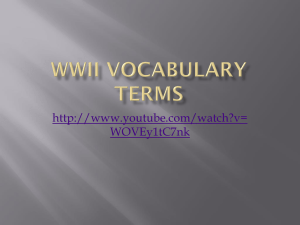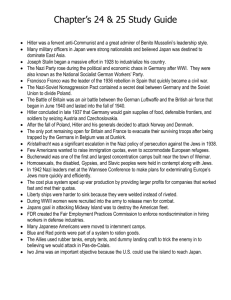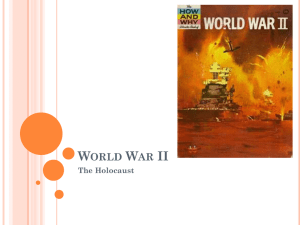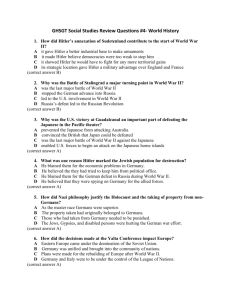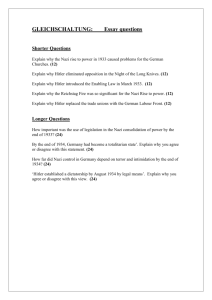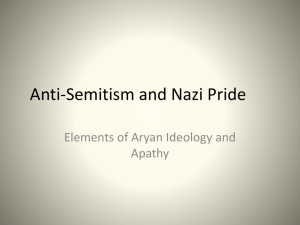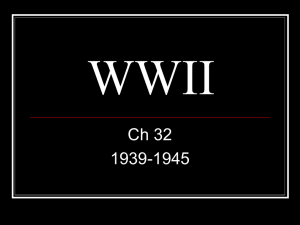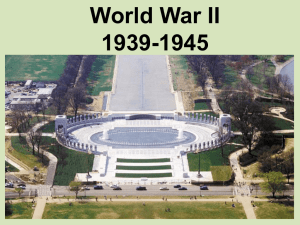WWII Study Guide Answers
advertisement
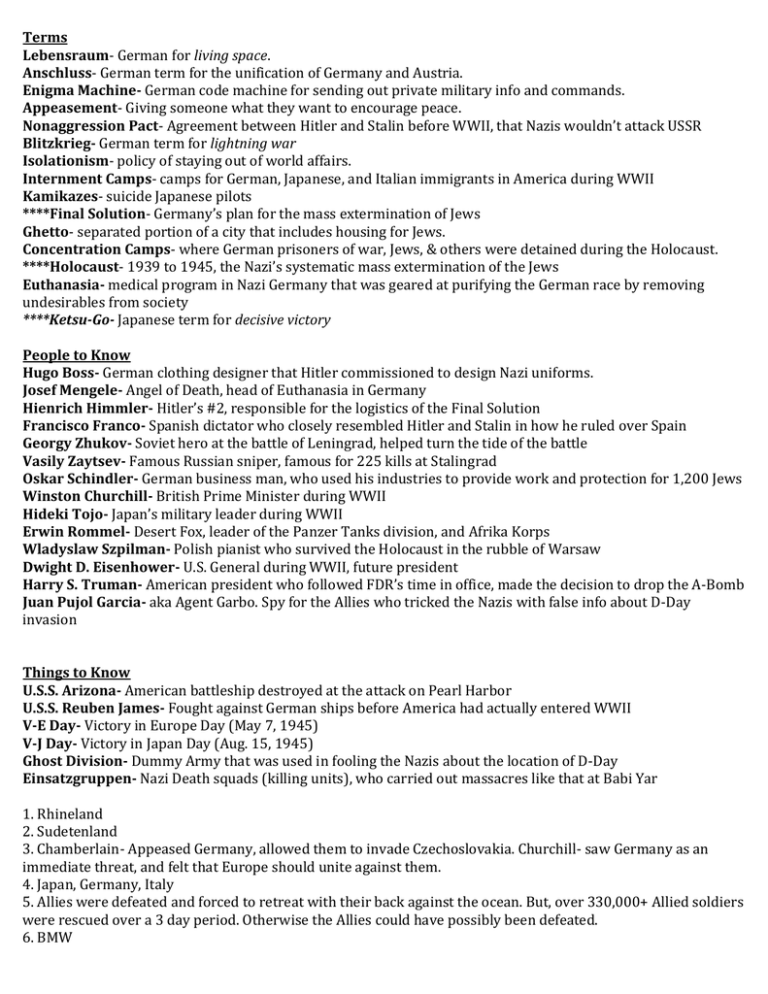
Terms Lebensraum- German for living space. Anschluss- German term for the unification of Germany and Austria. Enigma Machine- German code machine for sending out private military info and commands. Appeasement- Giving someone what they want to encourage peace. Nonaggression Pact- Agreement between Hitler and Stalin before WWII, that Nazis wouldn’t attack USSR Blitzkrieg- German term for lightning war Isolationism- policy of staying out of world affairs. Internment Camps- camps for German, Japanese, and Italian immigrants in America during WWII Kamikazes- suicide Japanese pilots ****Final Solution- Germany’s plan for the mass extermination of Jews Ghetto- separated portion of a city that includes housing for Jews. Concentration Camps- where German prisoners of war, Jews, & others were detained during the Holocaust. ****Holocaust- 1939 to 1945, the Nazi’s systematic mass extermination of the Jews Euthanasia- medical program in Nazi Germany that was geared at purifying the German race by removing undesirables from society ****Ketsu-Go- Japanese term for decisive victory People to Know Hugo Boss- German clothing designer that Hitler commissioned to design Nazi uniforms. Josef Mengele- Angel of Death, head of Euthanasia in Germany Hienrich Himmler- Hitler’s #2, responsible for the logistics of the Final Solution Francisco Franco- Spanish dictator who closely resembled Hitler and Stalin in how he ruled over Spain Georgy Zhukov- Soviet hero at the battle of Leningrad, helped turn the tide of the battle Vasily Zaytsev- Famous Russian sniper, famous for 225 kills at Stalingrad Oskar Schindler- German business man, who used his industries to provide work and protection for 1,200 Jews Winston Churchill- British Prime Minister during WWII Hideki Tojo- Japan’s military leader during WWII Erwin Rommel- Desert Fox, leader of the Panzer Tanks division, and Afrika Korps Wladyslaw Szpilman- Polish pianist who survived the Holocaust in the rubble of Warsaw Dwight D. Eisenhower- U.S. General during WWII, future president Harry S. Truman- American president who followed FDR’s time in office, made the decision to drop the A-Bomb Juan Pujol Garcia- aka Agent Garbo. Spy for the Allies who tricked the Nazis with false info about D-Day invasion Things to Know U.S.S. Arizona- American battleship destroyed at the attack on Pearl Harbor U.S.S. Reuben James- Fought against German ships before America had actually entered WWII V-E Day- Victory in Europe Day (May 7, 1945) V-J Day- Victory in Japan Day (Aug. 15, 1945) Ghost Division- Dummy Army that was used in fooling the Nazis about the location of D-Day Einsatzgruppen- Nazi Death squads (killing units), who carried out massacres like that at Babi Yar 1. Rhineland 2. Sudetenland 3. Chamberlain- Appeased Germany, allowed them to invade Czechoslovakia. Churchill- saw Germany as an immediate threat, and felt that Europe should unite against them. 4. Japan, Germany, Italy 5. Allies were defeated and forced to retreat with their back against the ocean. But, over 330,000+ Allied soldiers were rescued over a 3 day period. Otherwise the Allies could have possibly been defeated. 6. BMW 7. 37 straight weeks of bombings by the Nazis on the city of London. 40,000 civilians killed. Hitler’s attempt to get the British to surrender. 8. Surprise attack by Japanese on an American port where our Pacific Navy fleet was stationed. 2 hours long, 2,000 killed. 9. Scrapped iron and other metals, and conserved and recycled rubber, paper products, and fuel for war effort. 10. Suez Canal was the connecting body of water for the Middle Eastern oil producing countries and the Mediterranean Sea. Allies depended on the oil for their war effort. 11. Libya; Egypt; Battle of El Alamein 12. Afrika Korps 13. Northern Africa 14. Sicily 15. He was rescued by Nazi forces at the command of Hitler, and would go on to be used as a puppet leader by Hitler in Northern Italy 16. Nazis surrounded and blockaded the city. As many as 3-4,000 were starving daily. 1 million civilians died, but the Soviet citizens and military in the city outlasted the Nazi blockade. Major victory for USSR 17. -One of the largest cities in Russia. -Its factories produced tanks, guns, etc. -Major ports on the Volga shipped products throughout Russia. -Carried Stalin’s name. -Largest and bloodiest battle in history. 18. 9 million 19. Most countries would not accept poor immigrants, and since Jews were financially crippled by Nazi laws, emigration was difficult. The U.S. and other countries were recovering from the Great Depression, and the U.S. began limiting immigration numbers by the late 1920’s. 20. Slavs, Poles, the Romany (Gypsies), homosexuals, and the disabled. 21. 5 million; 6 million 22. At Babi Yar (Russia), Nazis carried out the mass murder of 35,000 Jews in a 2-day span. 23. Auschwitz 24. Buchenwald 25. Kept Japanese from conquering strategic British ports in Australia. 26. Outnumbered in terms of ships and firepower, but the U.S. Navy would still defeat the Japanese, thanks to cracking the Japanese’s codes, and finding out when and how they would attack. 27. -Took over a year to plan. -Invasion had to be by sea, and made against strong German defenses. -Specialized equipment would have to made to transport tanks, troops, and supplies. -There was also a complex plan to mislead Hitler about the location of the invasion. -Over 156,000 Allied troops would be used in the invasion -10,000 Allied killed on D-Day alone. 28. Allies were able to stop the last major offensive launched by Hitler. Took place in Belgium, cost 100,000 Allied lives though. 29. Okinawa and Iwo Jima; 20,000 30. Hiroshima; Nagasaki 31. Estimated that it would cost 1 million Allied lives. Japanese would kill thousands of U.S. POWs located there. Millions more Japanese lives would be lost to an invasion. Japanese would not give up easily (ketsu-go) 32. Agreement between U.S. and Britain -Neither country would seek territorial gain. -Work together for mutual prosperity. 33. Yalta



